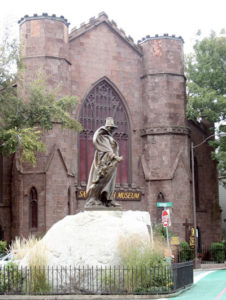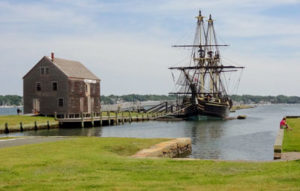Witch Way to Salem?

Just a 30-minute train ride north of Boston is Salem, Massachusetts, one of America’s oldest and curious cities. Located on the North Shore of Massachusetts, Salem was one of the most significant colonial and early American seaports as well as having a rich New England history with glory and intrigue. Salem is a small, compact and walkable historic city with just over 40,000 residents and hundreds colonial-era buildings along with more than 60 restaurants, cafes and coffee shops. Over a million tourists visit annually with Halloween, October 31, being the peak where upwards of 70,000 people come to celebrate.
Much of the city’s cultural identity is defined by the Salem Witch Trials of 1692, 63 years after the founding of the city. Salem is widely known as “Witch City” with the High School’s nick name being “the Witches,” police cars have witch logos, one of the elementary schools is Witchcraft Heights Elementary School and it is hard to walk a single block without seeing witch T-shirts and other occult paraphernalia. The city even has a Harry Potter shop, and in 2015 a local witch successfully sued a local warlock! The culture of witchcraft in Salem as a symbol of Salem is a conscious product promoted by the city and its businesses to drive tourism and was mostly created in the second half of the 20th century. Salem, however, is much, much more than ghosts, goblins and witches.
The culture of witchcraft in Salem as a symbol of Salem is a conscious product promoted by the city and its businesses to drive tourism and was mostly created in the second half of the 20th century. Salem, however, is much, much more than ghosts, goblins and witches.
Prior to the arrival of European settlers, the region was home to a long-term Native American village and trading center. In 1626 a group of European fishermen from Cape Ann (just to the northeast) settled in the area led by Roger Conant. Just two years after their arrival, the Massachusetts Bay Company replaced Conant with John Endicott as the leader of the settlement and eventually governor of the larger Massachusetts Bay Colony. Because the transition was peaceful between the two leaders and their associates, the name of the settlement was changed from Naumkeag to Salem after the Hebrew word shalom meaning peace. In 1630 the Great Migration began and many puritans sailed to Massachusetts. The puritans travelled here to obtain religious freedom for themselves, but did not extend that freedom to other faiths. In 1636 the first trade ship from Salem sailed to the West Indies to trade salt cod. In 1637 when Salem had about 900 inhabitants, it held the first gathering, or muster, of a local militia on the Salem Common. All males between 16 and 60 had to possess arms and participate in the defense of the community. Because of this action, Salem has been designated as the birthplace of the US National Guard and signed into law by president Obama in 2013.
Because the transition was peaceful between the two leaders and their associates, the name of the settlement was changed from Naumkeag to Salem after the Hebrew word shalom meaning peace.

Salem’s most famous puritan-era event was the witch trials of 1692. At the time people believed that witchcraft was real and evil. Nothing caused more fear in the puritans than the thought that people in their community were possessed by demons. It was a hysterical time for many. In only three months’ time 19 innocent people were hanged, and one man was pressed to death. The trials ended when Governor Phipps’ wife was accused of being a witch. A new court was established and it released those awaiting trial and pardoned those awaiting execution. After the witch trials ended, Salem continued to grow and prosper with an economy based on fishing, agriculture and trade. The shipping industry continued to grow under colonial leadership and by the 1760’s there were almost 50 large wharves in Salem handling a growing global trade.
Many people think that the first military engagement with the British occurred in Lexington and Concord, but it was here in Salem. The first armed resistance of the Revolution occurred in 1775 when Salem’s militia blocked British Colonel Leslie and his men from capturing ammunition that was stored in Salem. During the American Revolution, Salem became a center of privateering and over 800 vessels were commissioned as privateers and they destroyed some 600 British ships. Nearby Marblehead is known as the birthplace of the American Navy (though Beverly, Massachusetts, and Whitehall, in New York, also make this claim). After the Revolutionary War many ships from Salem returned to commerce and sailed around the world trading in many ports throughout the seven seas. The East Indies, West Indies and China became major destinations for Salem’s traders. By 1790, Salem was America’s seventh largest city, but the richest per capita and a world famous trading port, much more important than Boston. In some foreign harbors people thought that Salem was a country not a city. When the War of 1812 started up, Salem once again became a center of privateering, but by the end of the war, Salem’s shallow harbor, smaller economies of scale, and competition with Boston and New York led to a sharp decline. By 1850, Salem was no longer a major American port.

Throughout its history Salem has produced many scholars and authors with Nathaniel Bowditch (1773 – 1838) and Nathanial Hawthorne (1804 – 64) being the most famous. Bowditch is credited as the founder of modern maritime navigation. He was a mathematician by trade and was largely self-taught. At age 10 he had to quit school to work in his father’s cooperage and then at age 12 he became indentured for nine years as a bookkeeper to a ship supply store. He spent years teaching himself mathematics, Latin and other subjects. At age 29 (1802) his book The American Practical Navigator was first published and is still carried on board every commissioned US Navy vessel. Nathanial Hawthorne is the great-great grandson of John Hathorne, the only witch trials judge who never repented for his actions. Hawthorne’s work drew from puritan inspiration and his themes often focused on the evil and sin of humanity. Hawthorne produced many short stories and novels; The Scarlet Letter is certainly his most famous work and the supposed namesake of The House of Seven Gables has become a tourist destination. There is also a strong tie between Hawthorne and Salem’s maritime traditions as he served as the customs collector for two years in the 1840s.

For most of the 19th and 20th centuries, Salem became a second tier industrial city noted for its textiles (cotton sheeting), leather tanneries, shoe making, and diverse manufactures. Surprisingly, the Parker brothers came from Salem and the game Monopoly was produced here as well as several other board games. Salem became an integral part of Boston’s extended hinterland and part of its suburban belt. However, it has always retained its historic identity.
Today, Salem is a vibrant city on the North Shore famous for its history, tourism, higher education (Salem State University) and medical centers as well as being an up-and-coming bedroom community for Boston. Salem has preserved much of its glorious past. The sailing era of the 18th century can be seen in two historic districts, the Chestnut Street District with over 400 magnificent buildings from the era and the greatest concentrations of notable pre-1900 domestic structures in the United States. Important tourist sites include the Salem Maritime National Historic Site, consisting of 12 key builds and almost nine acres of open space along the harbor, The Peabody Essex Museum, established by ship captains and mates in 1799 which began by exhibiting “curiosities” from around the world. Today, the museum focuses on art and culture with world class exhibits drawn from around the world.
Salem is easy to reach from Boston and there is plenty to do for families and adults for a day or more with a variety of activities from visiting historic homes, going to museums, engaging with local witches, people watching from sidewalk cafes and strolling through various shops. Come and join us on our AAG-sponsored trip to Salem during the conference or travel there by yourself. From North Station in Boston there are over 30 trains during the week and fewer on the weekends.
Salem Home Page: https://salem.org/
—Stephen Young and Stephen Matchak
Salem State University


